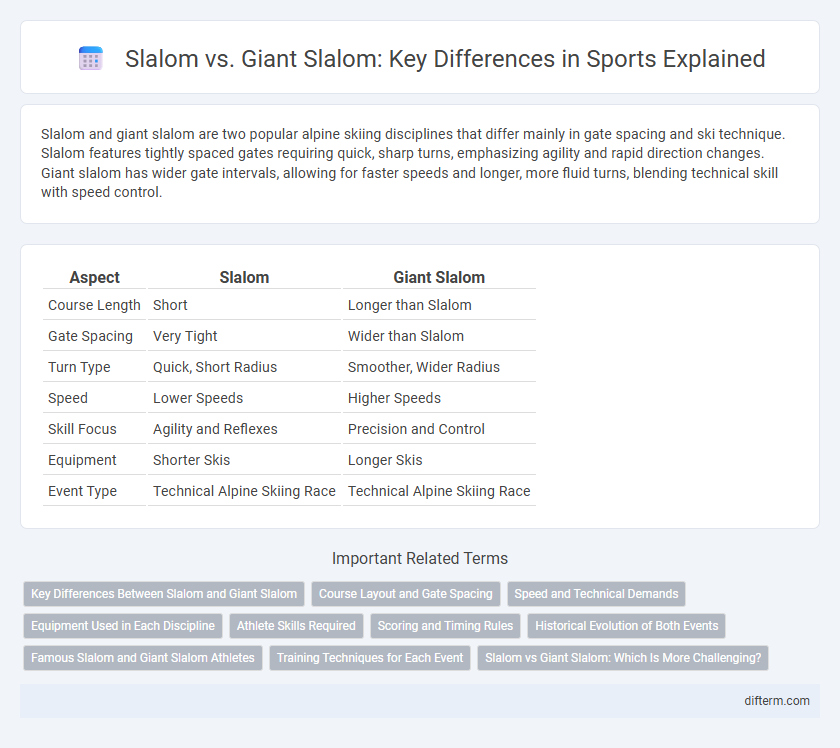Slalom and giant slalom are two popular alpine skiing disciplines that differ mainly in gate spacing and ski technique. Slalom features tightly spaced gates requiring quick, sharp turns, emphasizing agility and rapid direction changes. Giant slalom has wider gate intervals, allowing for faster speeds and longer, more fluid turns, blending technical skill with speed control.
Table of Comparison
| Aspect | Slalom | Giant Slalom |
|---|---|---|
| Course Length | Short | Longer than Slalom |
| Gate Spacing | Very Tight | Wider than Slalom |
| Turn Type | Quick, Short Radius | Smoother, Wider Radius |
| Speed | Lower Speeds | Higher Speeds |
| Skill Focus | Agility and Reflexes | Precision and Control |
| Equipment | Shorter Skis | Longer Skis |
| Event Type | Technical Alpine Skiing Race | Technical Alpine Skiing Race |
Key Differences Between Slalom and Giant Slalom
Slalom features shorter, tighter turns with gates spaced closer together, demanding rapid agility and precise maneuvering. Giant Slalom involves wider, faster turns with gates set farther apart, emphasizing speed and smooth, carving techniques. The differences in course design significantly affect athlete strategy and equipment selection, with slalom requiring quicker reflexes and giant slalom prioritizing stability at higher speeds.
Course Layout and Gate Spacing
Slalom courses feature tightly spaced gates requiring quick, short turns, typically set 6 to 13 meters apart, emphasizing agility and rapid direction changes. Giant slalom courses have wider gate spacing, usually 10 to 15 meters, allowing for longer, smoother turns and higher speeds on a more open layout. The difference in course design affects skiing technique, with slalom demanding precision and quick reflexes, while giant slalom prioritizes speed and controlled carving.
Speed and Technical Demands
Slalom racing requires sharp, quick turns around tightly spaced gates, demanding exceptional technical skill and rapid agility from athletes. Giant slalom features wider turns and higher speeds, balancing technical precision with increased velocity on longer courses. Speed in giant slalom surpasses that of slalom, but slalom is considered more technically demanding due to its rapid directional changes.
Equipment Used in Each Discipline
Slalom requires shorter, more flexible skis that enhance quick, tight turns, while giant slalom uses longer, stiffer skis designed for stability at higher speeds and wider turns. Ski boots for slalom offer increased lateral support to manage rapid directional changes, whereas giant slalom boots emphasize rigidity for precise edge control and power transfer. Pole design also differs, with slalom poles featuring guards for gate protection, contrasting with the simpler poles used in giant slalom competitions.
Athlete Skills Required
Slalom requires athletes to have exceptional agility, quick reflexes, and precise timing to navigate closely spaced gates at high speeds. Giant slalom demands a blend of technical skill and speed, with athletes needing strong edge control and the ability to maintain balance through longer, sweeping turns. Mastery in both disciplines hinges on advanced coordination, muscular endurance, and strategic line selection to optimize race times.
Scoring and Timing Rules
Slalom events feature tighter gates and shorter courses, requiring skiers to complete more turns with a focus on agility, where timing penalties for gate misses typically add seconds or lead to disqualification. Giant slalom courses have wider and more spaced gates, emphasizing speed combined with precision, with scoring based strictly on the fastest time and penalties incurred for missed gates or false starts. Both disciplines use electronic timing systems accurate to hundredths of a second to rank athletes, but the slalom often involves additional penalties due to its technical difficulty.
Historical Evolution of Both Events
Slalom and giant slalom have evolved significantly since their origins in the early 20th century, with slalom first introduced in 1931 as a test of quick, short turns on closely spaced gates. Giant slalom emerged in the 1940s to challenge athletes with wider, faster turns requiring greater precision and speed, marking a key development in competitive alpine skiing. Both events have since influenced the technical standards and equipment innovations in skiing, shaping modern winter sports competitions worldwide.
Famous Slalom and Giant Slalom Athletes
Mikaela Shiffrin, a dominant figure in alpine skiing, excels in both slalom and giant slalom events, holding multiple World Cup titles. Marcel Hirscher, renowned for his technical skills, has achieved unparalleled success in slalom and giant slalom disciplines throughout his career. Lindsey Vonn, while mainly influential in downhill and super-G, has also competed at a high level in giant slalom, showcasing versatility among skiing legends.
Training Techniques for Each Event
Slalom training emphasizes quick, precise turns with rapid edge changes to navigate tightly spaced gates, using short radius turns and agility drills that enhance reaction time and balance. Giant slalom training focuses on longer, smoother turns requiring speed control and line optimization, incorporating exercises that build strength, endurance, and carving technique for maintaining momentum through wider gates. Both events benefit from video analysis and course simulation to improve tactical decision-making and refine technical skills specific to gate spacing and turn dynamics.
Slalom vs Giant Slalom: Which Is More Challenging?
Slalom features shorter, tighter turns with gates spaced closer together, demanding quick reflexes and precise edge control, while Giant Slalom requires skiers to navigate wider, faster turns with gates set further apart, testing speed and technique endurance. The increased technical difficulty in Slalom makes it more challenging for agility and rapid direction changes, whereas Giant Slalom challenges racers with high-speed stability and sustained control. Race data from FIS World Cup events show that athletes typically experience higher average speeds in Giant Slalom but greater technical complexity in Slalom, highlighting the distinct demands of each discipline.
slalom vs giant slalom Infographic

 difterm.com
difterm.com